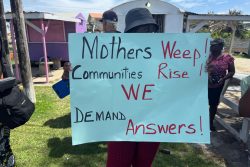Part 2
The previous column argues that old-fashioned textbook Keynesian macroeconomics, in terms of budget stimulus, will not be very effective in a country like Guyana that exports most of what it produces and imports a large percentage of what it consumes. A version of the last sentence was invented by Prof Clive Thomas back in the late 1960s. It implies that government stimulus is more likely to boost demand for imports and scarce foreign exchange than domestic production.
The aspect of domestic production that will be stimulated would be non-tradable goods and services such as haircuts and general grooming, carpentry services, electrical services, entertainment, Banks beer, restaurant meals, bora and okra at the local market, etc. Guyana’s core production – sugar, rice, bauxite, timber and gold – is consumed mainly outside the country and therefore depends on foreign demand; not demand created by internal government spending.
 This implies that the fortune of the country moves with the business cycle generated by foreign event shocks. The cycle moves around or fluctuates around a fairly flat long-term trend GDP growth rate. The cycles are often misplaced for the trend. So, for example, we can have a few good years because of a global commodity price boom. But the long-term trend is still constrained by backward politics, voters’ preferences for race and patronage instead of policies, and environmental and natural constraints.
This implies that the fortune of the country moves with the business cycle generated by foreign event shocks. The cycle moves around or fluctuates around a fairly flat long-term trend GDP growth rate. The cycles are often misplaced for the trend. So, for example, we can have a few good years because of a global commodity price boom. But the long-term trend is still constrained by backward politics, voters’ preferences for race and patronage instead of policies, and environmental and natural constraints.
My reading of Budget 2016 suggests that Minister Jordan has his eyes focused on the long term, which might have elicited disparagements from the political types who only focus on the cycles around the virtually flat trend from 1960 to 2015. Several progressive policies were outlined such as making sure Guyanese can buy relatively newer vehicles and new tyres. Over time the middle class will benefit and save money from owning newer vehicles, and probably save themselves from road accidents. By Budget 2017 there should be a further reduction of the taxes on newer vehicles and complete removal of taxes on new tyres. This is yet another reason why the VAT should remain at 16% in order to finance the reduction in these miscellaneous taxes and the expansion of zero-rating of the things consumed by the poor.
In addition to allowing for newer vehicles, several proposals for the greening of the economy were made including the rehabilitation of urban parks, restoration of mangroves, and the banning of harmful containers. These are all enlightened proposals that will make a better country and improve the well-being of everyone. On the theme of enlightenment, furthermore, the budget recognizes the importance of data for decision making. It promises $260 million over four years, a number however that seems too small but a start nevertheless.
There are a few plans in the budget that could engender a favourable structural break in the flat long-term trend growth. This will not occur in one year, but will take multiple years to realize. There will be capacity constraints such as the shortage of skilled workers, engineers and credible contractors. The topography of the coastal plain will slow down the implementation of the new road projects. The budget allocates $14 billion to maintaining and upgrading present road systems, most likely creating a much needed short-term injection into the economy. Note, replenishing depreciation of existing infrastructure is essential but does not really change the trend growth rate of the economy.
The government is continuing several common sense projects the PPP had on its front burner. The expansion of the runway of the Cheddi Jagan International Airport is something new that could create seminal possibilities for breaking the trend. The reconstruction of Sheriff Street is another. Perhaps the most important would be the proposal to create a completely fresh highway from Diamond to Ogle. One wonders why this highway was never a priority five years ago. A loan of US$50 million is being negotiated with the Indian government for this project. The latter will take a very long time to complete and the project will face capacity and topographical constraints, but it has to be built. Negotiations are in place with the Government of China for the construction of the East Coast Highway from Better Hope to Belfield.
The proposed waterfront development for Kitty, Kingston, Stabroek, Vreed-en-Hoop, Supenaam and Skeldon will be good for aesthetics, enhance business opportunities and lift up the human spirit. The term production transformation – a much discussed term of Development Watch – enters the budget. To accomplish structural production change the Budget alluded to the five Fs – food security, fibre and nutritious food, fuel production, fashion and health products, and furniture and craft. Obviously these are all good intentions, but not much was said about who will produce them, who will finance them and where the production will be located. What kind of fuel production is envisaged? Would it be crude oil or a portfolio of renewable energies? Or will there be a sensible combination of fossil fuels and renewable energy sources? These are obviously questions beyond the mandate of an annual budget, thus further underscoring the need for a long-term vision coming out from the Ministry of the Presidency.
In the spirit of enlightenment and steepening the long-term growth trend, the budget presents a massive increase in education spending. Tertiary education is given a major boost; particularly, the $3.2 billion allocated to the University of Guyana, representing a 52% increase from the previous year. This is a step in the right direction. But buildings don’t make a great university. Significant allocations have to go into training and attracting experts in various fields. Expert faculties make a university. The same can be said about primary and secondary education. Unless there are teachers who are experts in the respective subjects the students will not be motivated to learn, especially boys. The term STEM education is popular these days. It is often forgotten that several disciplines of quantitative Social Sciences are also part of the STEM system. If UG is going to mould engineers who can only conceptualize private cost and benefits and exclude social benefit-cost you still have a big problem. Of course, the latter is a mandate beyond a budget exercise and requires leadership on the education front.
There is also significant increase in the allocation for health amounting to $28 billion, a 10.9% increase from the previous budget. This is all great, but serious attention has to go into training nurses, nurse practitioners, physician assistants and medical doctors. These are the people who will make a great healthcare system. The government has to pay keen attention to bona fide credentials. Private hospitals should be given incentives to expand and search for the best medical practitioners. If the private system works better there will be favourable spill over to the public system. Let specialty hospitals bloom!
In an economy such as Guyana the long-term rate of growth is constrained by the amount of foreign exchange that is available to the system. In this regard, the budget deficit and how it is financed are crucial issues. Budget 2016 will widen the fiscal deficit. The distributional conflicts sparked by the 50% salary increase for ministers will add pressure from others for large salary increases. Soon I will discuss the state of the fiscal deficit and some ominous trends.
Comments: tkhemraj@ncf.edu









